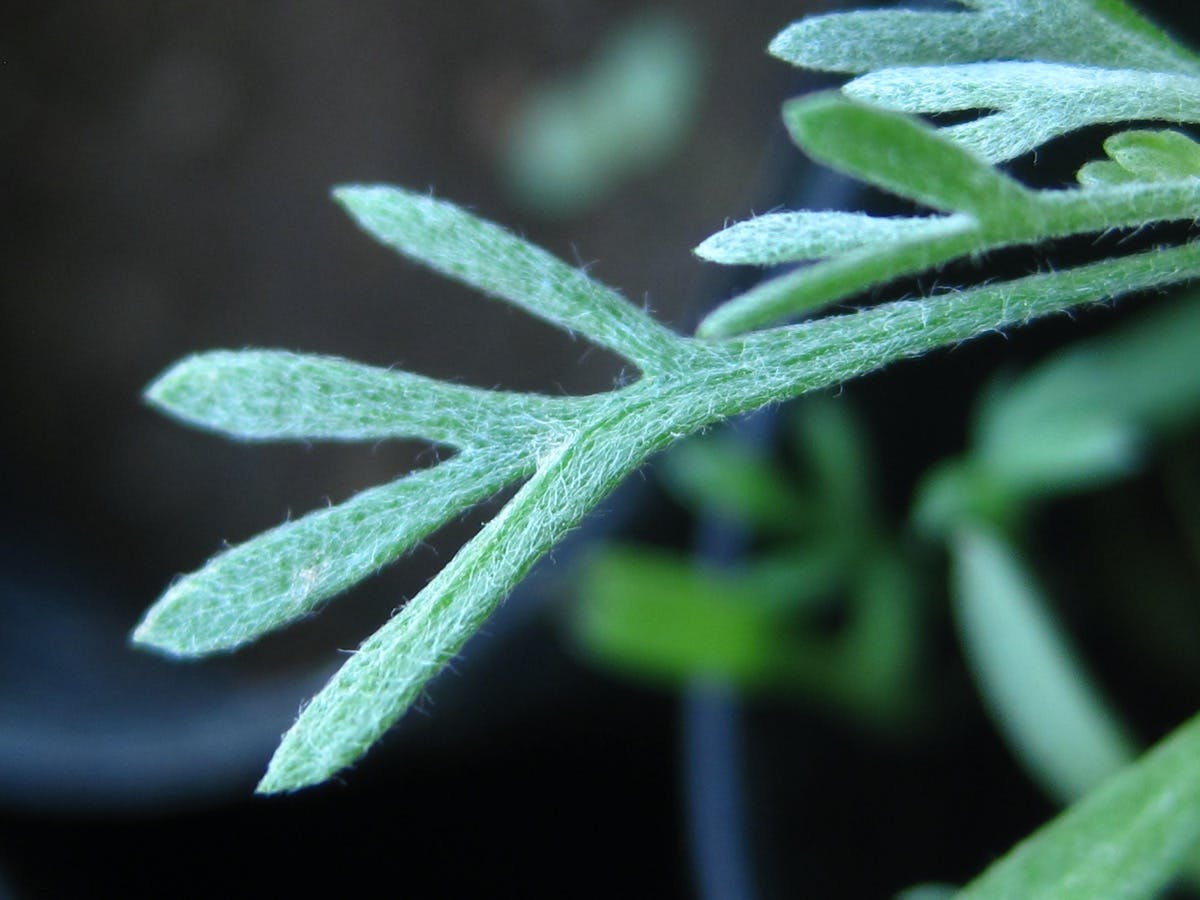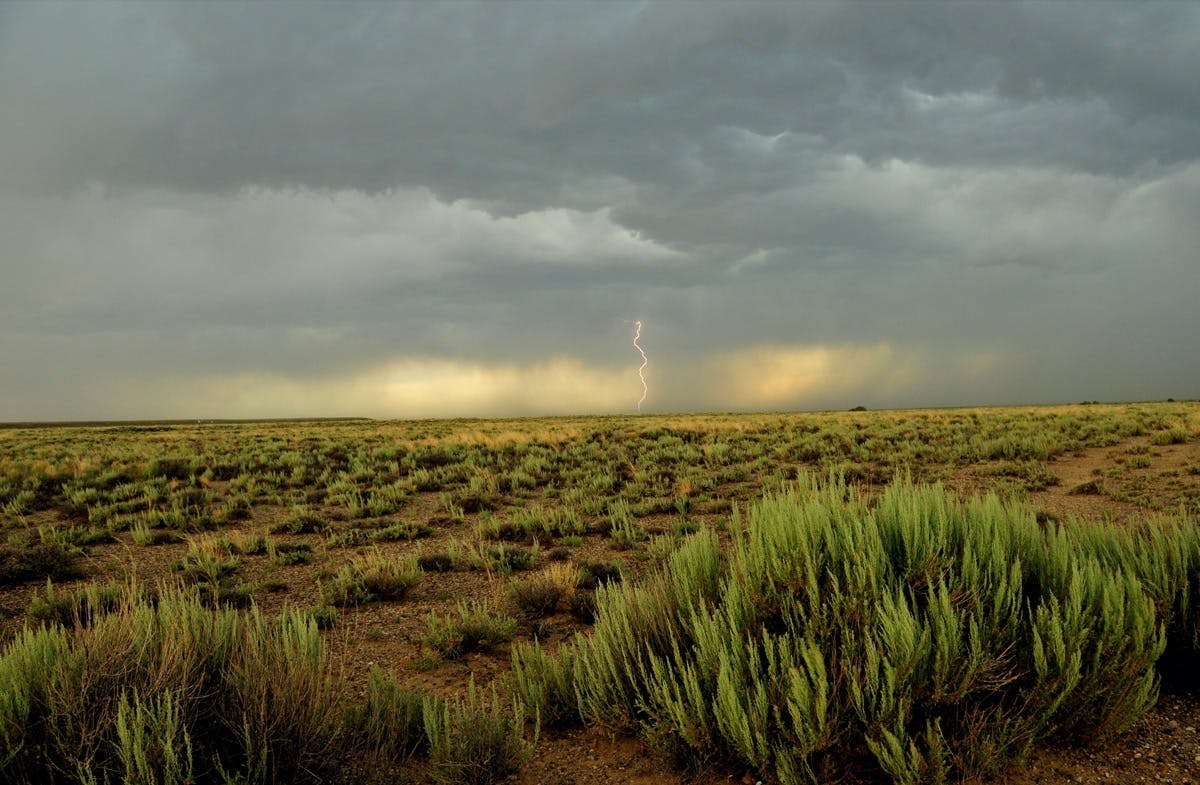The big sagebrush is far from your typical tumbleweed. In the dry landscape of the American West, the sun catches the plant’s fine silver hair like light reflecting off a stormy ocean. Growing as tall as your thigh, their lanky limbs seem frozen in a permanently petrified stance.
“They kind of look like tortured little bonsai trees,” says Kathryn Turner, an evolutionary ecologist and assistant professor at Idaho State University. But this delicate bush is an essential native plant for desert wildlife—and it’s under threat.
Eighteen sagebrush species grow throughout North America’s Great Basin, a massive network of watersheds and prairies that spans the arid lands of Nevada, Utah, Idaho, Oregon, and California. Sagebrush growing here creates the largest interconnected habitat in North America, spanning across 175 million acres. This keystone plant supports over 350 species, including the adorable pygmy rabbit and charismatic greater sage-grouse.
“It’s one of the only things around here that’s really green all year round,” says Elizabeth Leger, professor and director of the Museum of Natural History at the University of Nevada, Reno.
“It’s literally the foundational shrub of this whole huge, cold desert area.”

A closeup of a sagebrush's narrow segmented leaves reveals its tiny silver hairs
Matt Germino/USGS (Public Domain)
While mostly recognized for its sea foam-green luster, sagebrush is actually part of the sunflower family. In the late summer and fall, small light yellow buds bloom “off the top of the shrub, kind of like candles on a birthday cake,” says Leger. Big sagebrush, scientifically known as Artemisia tridentata, is even Nevada’s official state flower. But unlike springtime bluebonnets and poppies, she says, “They’re not really showy flowers.” You have to look close to see the dozens of tiny flowers dotting the stalks.
Maybe even more distinct than its little florets is the smell of sagebrush, which shares the same genus as absinth. Not to be confused with the sage herb that you use to season your cooking, “sagebrush has this wonderful really herbal spikey smell,” Turner says. The plants unleash a pungent musk of camphor and aromatic compounds, particularly after a desert rain. The fragrance lures various wildlife, but Turner says “in order to eat it, these herbivores have had to adapt to deal with these particular compounds.”
For many birds and animals, the tiny flowers and leaves are delicacies. Sagebrush are “the grocery store” in these desert ecosystems, Leger explains, supporting large communities of birds, reptiles, pronghorns, and mule deer. If you’re lucky, you might spot a pygmy rabbit or the greater sage-grouse nibbling on the plant. During the winter, it becomes almost 100% of the adult sage grouse diet, as it stays alive and leafy above the snow line.
Sagebrush also acts as a soil anchor and canopy for communities of wildflowers and other small plants. “If you put a big shrub out in the middle of the desert, one thing it’s going to do is collect nutrients around it,” says Turner. “The wind will blow topsoil to the base of the sagebrush, and it’ll settle there. So they kind of act as these fertility islands for other plants.”
But this icon of the American West is under constant stress. Increasing wildfires, invasive plants, and human land use have quickly changed the Great Basin’s landscapes, putting pressure on its wildlife. Alarmed scientists, such as Turner and Leger, are now trying to assess how the diminishing sagebrush is impacting already threatened species.
“Sage grouse, which is constantly being discussed for [its endangered species] listing, has had its habitat decline, and its numbers are plummeting,” says Leger. “It’s almost certainly because of direct loss of sagebrush habitat.”
Hundreds of years ago, a sea of sagebrush washed over great swaths of the continent, stretching from Northern Canada to Northern Mexico. It’s estimated that sagebrush used to cover more than 280 million acres. But since European colonization, this habitat range has been cut in at least half, according to a 2012 report.
A lot of this loss is due to human activity. When settlers moved west in the mid and late-1800s, “they had these huge herds of grazing animals that basically mowed down all the native plants,” Leger says. Through the 1920s and 1930s, people intentionally plowed down and burned sagebrush and other native bunchgrasses to make way for livestock, crops and growing cities, Leger explains. “Even in the 1960s, you can find these old pamphlets about how to get rid of this ‘rangeland weed.’”

Greater sage-grouse thrives in sagebrush habitats
Tom Koerner/U.S. Fish and Wildlife Service on Flickr (Public Domain)
Sagebrush has also fallen victim to the west’s raging wildfires. These fires can be devastating to ecosystems. “After fire in the Great Basin, you go from these like landscapes covered with plants to this moonscape-looking situation,” Leger says.
In the ashes, there is unfortunately one plant that thrives: an unruly, straw-colored invasive species known as cheatgrass. Brought to the west by European settlers in the 1800s, cheatgrass is well-adapted to fire. Once it takes hold, it runs rampant, quickly sapping up resources and dominating other species. “Cheatgrass is like a sprinter, whereas our native plants are more like marathon runners,” says Leger. “One-to-one with another seedling, cheatgrass always wins.”
Unlike sagebrush, cheatgrass is not a convenient food source. Greater sage-grouse, pygmy rabbits, and other native wildlife don’t eat cheatgrass—and those animals and livestock that do only get a short grazing season. “You get grass for like five minutes, and it dries up and you have a giant pile of annual weeds,” Leger says.
But these dried-out weeds are perfect fuel for future fires. Cheatgrass not only takes advantage of landscapes devastated by wildfires, but can make future fires worse. This vicious cycle means that the sagebrush that manages to live alongside cheatgrass are at jeopardy. Sagebrush, filled with essential oils and aromatic compounds, burns hot and fast, says Leger.
“It’s like a dead man walking,” Leger says. It can take as long as 30 years for a sagebrush stand to recover, she adds. And climate change is prolonging and worsening wildfire season, as it continues to make water irregular in the west. Areas of the sagebrush steppe are now burning once every five years or fewer, compared to once every 60 to 110 years. “If you keep having these repeated fires, it doesn’t have time to regrow before it burns again,” Leger says.
To make things worse, “climate change is making the hotter places where sagebrush lives too hot, potentially,” says Turner, explaining that it is causing sagebrush territory to shrivel at its southern edges. “It used to go all the way down to northern Mexico, but now it’s kind of hard to find even in Arizona.”
The loss of habitat is accelerating. In just the last half-century, an estimated 50% of sagebrush has been lost in the Great Basin alone.
“The sagebrush range is really fragmented, and it’s shrinking every year,” says Turner.
That’s why Turner and Leger are both working independently in their regions of the Great Basin to help restore the sagebrush habitat. As part of a larger multi-lab research project, Turner’s lab at Idaho State University is looking into the genetics and seed germination conditions of different sagebrush populations to help design plant communities that prevent invasive plants from returning after a fire. The team is investigating what seeds germinate at what layers of soil, and if those differences lead to traits that help plants survive under environmental stressors—like cold, drought, and post-fire conditions.
Turner says soil can serve as a kind of time machine: “Do older layers of soil have different species? Are the seeds of invasive species concentrated near the top?” Turner asks. “We are hoping to understand what members of this plant community can germinate after a fire, and therefore contribute to the new community.”

Sagebrush habitat is diminishing at an accelerated rate from mining and energy development, cropland conversion, invasive grasses, and increased wildfires
Tom Koerner/U.S. Fish and Wildlifeon Flickr (CC BY 2.0)
At the University of Nevada, Reno, Leger is unpacking similar questions by growing sagebrush and native plant species in test plots in the field and on campus to identify which species might grow better in these fire-disturbed, weed-ridden environments.
“That’s not what our native plants evolved to do. This is all sort of new to them, but we have found that some populations are better at growing in those really bad conditions than others,” she says.
Species that are smaller, emerge early from seeds, and grow a lot of roots may be able to better establish themselves against cheatgrass. The team recently published findings from their small-scale seed collecting, cleaning, and harvesting strategies in the spring 2021 issue of the journal Native Plants.
Turner and Leger’s research can help choose the best seeds of native plants and sagebrush to bring into a site for restoration. After a wildfire, restoration groups often go out to the scorched lands to plant seed mixes. One effort that has helped plant more than a million sagebrush seedlings is the Sagebrush in Prisons Project, coordinated by Stacy Moore of the Institute for Applied Ecology, Department of Corrections, and the Bureau of Land Management.
Since 2016, prison inmates have helped grow, care, plant, and transplant sagebrush seedlings to burned sites. Inmates at some of the facilities are paid a small wage, but all volunteer to participate. The program provides educational and field work opportunities, allowing inmates to connect with the environment and local community, says Leger, who has helped teach some of the classes at participating facilities.
“A bunch of my students and I have gone into the prisons to give lectures, and you’ll never find a more engaged audience. They want to learn all about these systems,” she says. “It’s really interesting to think about how in the 1930s we were plowing it under, and now sagebrush is part of this whole effort to do good in multiple ways.”
(Watch a video by Oregon Public Broadcasting profiling the project at one of the participating facilities, Snake River Correctional Institution in eastern Oregon.)
Sagebrush remains underappreciated by many, says Leger. For some, the endless vista of sagebrush in the American West may be an eyesore. “People joke that nobody wants to drive across Nevada, because all you do is look at a bunch of sagebrush,” Leger says. “I think people who drive by it every day, take it for granted.”
But scientists who study these ecosystems, understand the value of this humble shrub, and the rippling consequences if it disappears. Leger looks out fondly at the “little remnant sagebrush community” growing wild in her backyard this spring—a silver-green oasis in the middle of the desert.
The Link LonkMay 31, 2021 at 11:26AM
https://ift.tt/3vFCVGv
The American West's sagebrush sea is rapidly vanishing - Massive Science
https://ift.tt/2CoSmg4
Sea
/cloudfront-us-east-2.images.arcpublishing.com/reuters/CZF6NULMVVMEXHOP7JK5BSPQUM.jpg)
No comments:
Post a Comment